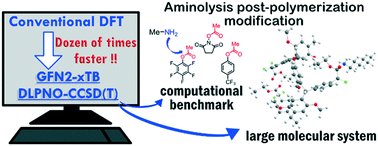Fast-track computational access to reaction mechanisms provides comprehensive insights into aminolysis postpolymerization modification reactions†
Abstract
With the aim of providing a computational guideline for activated ester–amine chemistry, a series of activated esters commonly used in polymer synthesis have been systematically analyzed at the DLPNO-CCSD(T) level of theory by taking advantage of the recently developed density functional theory-based semiempirical method GFN2-xTB. The fast-track computational analysis based on the GFN2-xTB and DLPNO-CCSD(T) methods can explain well the experimentally observed reactivity in aminolysis postpolymerization modification reactions. Moreover, transition state search calculations can be performed with realistic model structures consisting of more than a hundred atoms, offering a new approach for reaction profiling for large molecular systems without further approximations. The realistic reaction profiling allows a preliminary assessment and visualization of the polymer effect during the postpolymerization modification at the DLPNO-CCSD(T) level of theory. This study offers a computational compass for activated ester–amine chemistry for application in postpolymerization modification reactions.



 Please wait while we load your content...
Please wait while we load your content...